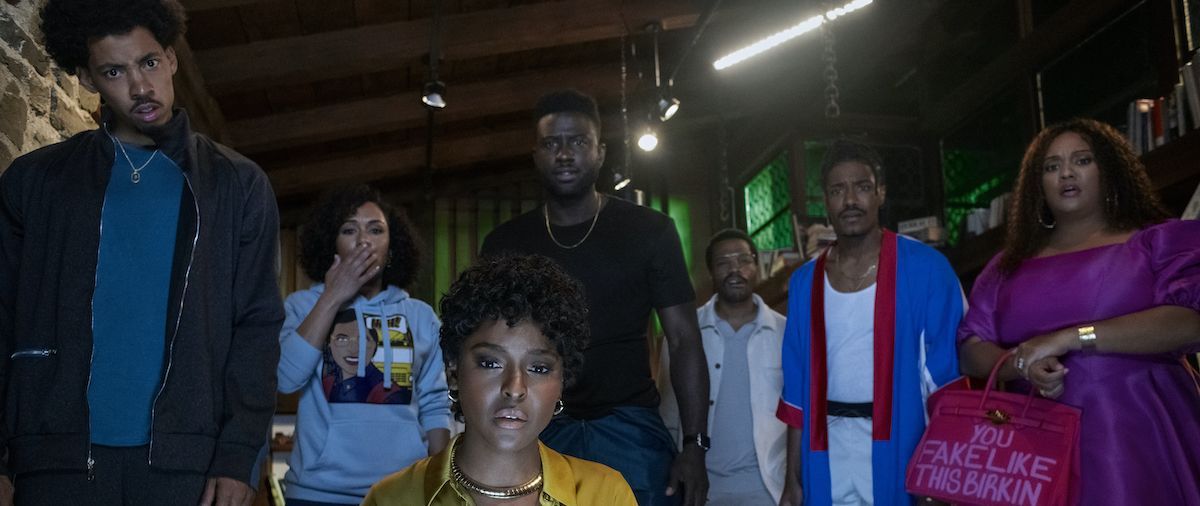Jonah Naplan July 11, 2023
Tim Story’s “The Blackening” is marketed with the tagline “We can’t all die first,” a smart blurb with loads of history that recedes it. Anyone who’s seen a horror movie knows that it’s frequently an underdeveloped Black character who dies first, or, for that matter, anyone who’s not white. In the case of this commentative film, everyone’s Black. So who’s the blackest? Who’s the weakest link? And does your Blackness need to have any singular definition?
Story, working with writers Dewayne Perkins and Tracy Oliver, explores these questions with the facade of a riotous slasher picture. Though his messages never thematically land in the way that they should, “The Blackening” is a sharply written piece of satire that’s a Black comedy through and through. It’s dark, it’s violent, it’s deeply political. Some will appreciate it more than others, and that’s okay. I found that it teetered on the edge of greatness. The fixings are all here, but something’s missing.
“The Blackening” follows a college reunion on Juneteenth at a cabin in the woods. Seven friends catch up, take shots, and play many rounds of Spades before being thrust into a deadly fight for survival. Stumbling across a mysterious board game called “The Blackening” with a racist Sambo at its center, the friends soon find themselves in the vicious clutches of a killer. Think “Jumanji” mixed with “Saw.” The game’s trivia cards not only force the group to rack their brains, trying to remember exactly how many seasons dark-skinned Aunt Viv was on “The Fresh Prince of Bel-Air” and the names of five Black actors who appeared on “Friends” (none of them have actually seen the show), but it also tests the strength of their friendship and the bond they have with one another. When posed with the impossible task of making a sacrifice, who will they choose?
The choices some of these characters make on this fateful night, along with what they prioritize, sacrifice, and disregard, do not entirely seem fitting with what we already learned about them from the expositional passages. Here’s what we do know: Dewayne (Dewayne Perkins), the gay best friend of Lisa (Antoinette Robertson) is frustrated that she continues to hook up with the historically unfaithful Nnamdi (Sinqua Walls). There’s uncertainty, mistrust, and anger amidst this trio, and it’s the movie’s most compelling dynamic. Granted a much less fortunate helping of development is everyone else: Clifton (Jermaine Fowler), the awkward Android user who reveals that he voted for Trump twice, in an effort to prove he’s not “the blackest,” the no-nonsense Shanika (X Mayo), Nnamdi’s best friend, King (Melvin Gregg), who’s married to a white woman, and the only biracial friend in the group, Allison (Grace Byers), sporting a Rosa Parks hoodie, and a visual for what the spectrum of Blackness actually looks like.
My favorite part of “The Blackening,” and where I think the screenplay is the strongest, is the disappointingly short scene in which the group actually plays the board game, answering the questions, arguing over the answers, shouting at each other, all while the ticking clock continues to count down for each one. Once the questions run out, “The Blackening” turns into full-fledged slasher territory. I would have liked to have seen a tighter version of “The Blackening” that entirely took place in the small, cramped game room, and did not stretch its legs beyond that. Once the characters leave that space, venturing out into the woods that surround their cabin, running after and from their killer, Story’s film loses focus.
“The Blackening” would have been much more chilling if the killer(s) involved were never actually shown, at least until the very end, but rather remained an elusive idea that mechanized the horror suspense machine. It’s far scarier to think about the suggestion of a masked killer than to see him face to face. Yet “The Blackening” depicts its villains in the flesh bright and early, sacrificing tense credibility and real scares for cheap jokes and a chance for the female characters to have their “girl power” moments.
That’s great and all, but a more tightly pressed version of this narrative could have given justice to the female characters in different, more resourceful ways, than having them raise hell upon their opposers with unnecessary bloodshed. Again, suggestion of violence is far more intriguing than its physical manifestation. Even so, the script is certainly acutely written, and much of the commentary is thorough without being offensive. Yet “The Blackening” feels much safer than I anticipated, and takes far less risks than I would have liked.
It never does anything completely outlandish, nothing to make our jaws drop, nothing that will make you turn to your neighbor and say: “I can’t believe they just said that.” It has wit. It makes you laugh. But it never makes you gawk, shout, or squeal with surprise.
Still, “The Blackening” is not completely unwatchable because of the expert commentary and the representation of Black folks up on screen. Anyone who has ever yelled at their television, fuming at the dumb mistakes the characters are making, will be able to get behind this movie in one way or another. But you’ll still ponder what could have been.

